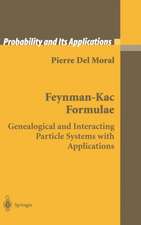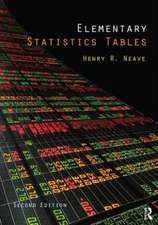Random Effect and Latent Variable Model Selection: Lecture Notes in Statistics, cartea 192
Editat de David Dunsonen Limba Engleză Paperback – 12 aug 2008
Din seria Lecture Notes in Statistics
- 15%
 Preț: 631.86 lei
Preț: 631.86 lei -
 Preț: 385.84 lei
Preț: 385.84 lei - 17%
 Preț: 490.20 lei
Preț: 490.20 lei - 17%
 Preț: 460.30 lei
Preț: 460.30 lei - 18%
 Preț: 945.92 lei
Preț: 945.92 lei - 20%
 Preț: 561.44 lei
Preț: 561.44 lei - 18%
 Preț: 943.25 lei
Preț: 943.25 lei - 18%
 Preț: 943.25 lei
Preț: 943.25 lei - 18%
 Preț: 990.57 lei
Preț: 990.57 lei - 15%
 Preț: 641.38 lei
Preț: 641.38 lei -
 Preț: 428.67 lei
Preț: 428.67 lei - 15%
 Preț: 633.53 lei
Preț: 633.53 lei - 15%
 Preț: 658.88 lei
Preț: 658.88 lei -
 Preț: 383.33 lei
Preț: 383.33 lei - 15%
 Preț: 640.71 lei
Preț: 640.71 lei - 18%
 Preț: 947.18 lei
Preț: 947.18 lei - 18%
 Preț: 1007.35 lei
Preț: 1007.35 lei - 18%
 Preț: 942.63 lei
Preț: 942.63 lei - 15%
 Preț: 639.59 lei
Preț: 639.59 lei - 18%
 Preț: 1231.47 lei
Preț: 1231.47 lei - 15%
 Preț: 643.00 lei
Preț: 643.00 lei - 18%
 Preț: 886.62 lei
Preț: 886.62 lei -
 Preț: 383.12 lei
Preț: 383.12 lei - 15%
 Preț: 633.35 lei
Preț: 633.35 lei - 15%
 Preț: 635.65 lei
Preț: 635.65 lei -
 Preț: 393.74 lei
Preț: 393.74 lei - 15%
 Preț: 632.70 lei
Preț: 632.70 lei - 15%
 Preț: 637.28 lei
Preț: 637.28 lei - 15%
 Preț: 702.87 lei
Preț: 702.87 lei - 15%
 Preț: 642.68 lei
Preț: 642.68 lei - 15%
 Preț: 644.63 lei
Preț: 644.63 lei - 15%
 Preț: 645.14 lei
Preț: 645.14 lei -
 Preț: 382.36 lei
Preț: 382.36 lei - 15%
 Preț: 636.30 lei
Preț: 636.30 lei - 15%
 Preț: 647.92 lei
Preț: 647.92 lei -
 Preț: 380.63 lei
Preț: 380.63 lei - 18%
 Preț: 887.05 lei
Preț: 887.05 lei - 15%
 Preț: 634.32 lei
Preț: 634.32 lei - 15%
 Preț: 648.74 lei
Preț: 648.74 lei -
 Preț: 378.92 lei
Preț: 378.92 lei - 15%
 Preț: 648.56 lei
Preț: 648.56 lei - 15%
 Preț: 647.59 lei
Preț: 647.59 lei - 18%
 Preț: 780.37 lei
Preț: 780.37 lei - 15%
 Preț: 641.20 lei
Preț: 641.20 lei - 18%
 Preț: 1102.69 lei
Preț: 1102.69 lei - 15%
 Preț: 643.16 lei
Preț: 643.16 lei -
 Preț: 384.70 lei
Preț: 384.70 lei
Preț: 381.98 lei
Nou
Puncte Express: 573
Preț estimativ în valută:
73.11€ • 79.45$ • 61.46£
73.11€ • 79.45$ • 61.46£
Carte tipărită la comandă
Livrare economică 21 aprilie-05 mai
Preluare comenzi: 021 569.72.76
Specificații
ISBN-13: 9780387767208
ISBN-10: 0387767207
Pagini: 170
Ilustrații: X, 170 p.
Dimensiuni: 155 x 235 x 10 mm
Greutate: 0.27 kg
Ediția:2008
Editura: Springer
Colecția Springer
Seria Lecture Notes in Statistics
Locul publicării:New York, NY, United States
ISBN-10: 0387767207
Pagini: 170
Ilustrații: X, 170 p.
Dimensiuni: 155 x 235 x 10 mm
Greutate: 0.27 kg
Ediția:2008
Editura: Springer
Colecția Springer
Seria Lecture Notes in Statistics
Locul publicării:New York, NY, United States
Public țintă
Professional/practitionerCuprins
Random Effects Models.- Likelihood Ratio Testing for Zero Variance Components in Linear Mixed Models.- Variance Component Testing in Generalized Linear Mixed Models for Longitudinal/Clustered Data and other Related Topics.- Bayesian Model Uncertainty in Mixed Effects Models.- Bayesian Variable Selection in Generalized Linear Mixed Models.- Factor Analysis and Structural Equations Models.- A Unified Approach to Two-Level Structural Equation Models and Linear Mixed Effects Models.- Bayesian Model Comparison of Structural Equation Models.- Bayesian Model Selection in Factor Analytic Models.
Recenzii
From the reviews:
“This book is a collection of review papers, of developments in a young and fast-moving field. It consists of two parts; on random effects models, and factor analysis and structural equation models. Within both of these, there is the familiar divide between frequentist and Bayesian methods, which receive separate reviews. The Bayesian methods are typically more recent developments, although almost all of the material covered is from the late 1980s and beyond. …This book offers researchers in this area several snapshots of current lines of research. Taken individually, the chapters offer concise and clear reviews of the more mature frequentist field, as well as clearly written introductions to newer Bayesian work.” (Biometrics, Summer 2009, 65, 993)
“The topics are appropriate and timely. The chapters are well written and well organized. … this book presents methods incorporating model uncertainty in random-effects and latent variable models. This concise, self-contained … application-based volume will be beneficial to graduate students and researchers interested in both theory and application. It also is suitable as a text for a graduate seminar … . I must commend the editor for providing a nice summary and discussion on the topics covered in the book … I enjoyed reading it!” (Technometrics, Vol. 51 (2), May, 2009)
“The topics are appropriate and timely. The chapters are well written and well organized. … this book presents methods incorporating model uncertainty in random-effects and latent variable models. This concise, self-contained … application-based volume will be beneficial to graduate students and researchers interested in both theory and application. It also is suitable as a text for a graduate seminar … . I must commend the editor for providing a nice summary and discussion on the topics covered in the book … I enjoyed reading it!” (Technometrics, Vol. 51 (2), May, 2009)
Textul de pe ultima copertă
Random effects and latent variable models are broadly used in analyses of multivariate data. These models can accommodate high dimensional data having a variety of measurement scales. Methods for model selection and comparison are needed in conducting hypothesis tests and in building sparse predictive models. However, classical methods for model comparison are not well justified in such settings.
This book presents state of the art methods for accommodating model uncertainty in random effects and latent variable models. It will appeal to students, applied data analysts, and experienced researchers. The chapters are based on the contributors’ research, with mathematical details minimized using applications-motivated descriptions.
The first part of the book focuses on frequentist likelihood ratio and score tests for zero variance components. Contributors include Xihong Lin, Daowen Zhang and Ciprian Crainiceanu.
The second part focuses on Bayesian methods for random effects selection in linear mixed effects and generalized linear mixed models. Contributors include David Dunson and collaborators Bo Cai and Saki Kinney.
The final part focuses on structural equation models, with Peter Bentler and Jiajuan Liang presenting a frequentist approach, Sik-Yum Lee and Xin-Yuan Song presenting a Bayesian approach based on path sampling, and Joyee Ghosh and David Dunson proposing a method for default prior specification and efficient posterior computation.
David Dunson is Professor in the Department of Statistical Science at Duke University. He is an international authority on Bayesian methods for correlated data, a fellow of the American Statistical Association, and winner of the David Byar and Mortimer Spiegelman Awards.
This book presents state of the art methods for accommodating model uncertainty in random effects and latent variable models. It will appeal to students, applied data analysts, and experienced researchers. The chapters are based on the contributors’ research, with mathematical details minimized using applications-motivated descriptions.
The first part of the book focuses on frequentist likelihood ratio and score tests for zero variance components. Contributors include Xihong Lin, Daowen Zhang and Ciprian Crainiceanu.
The second part focuses on Bayesian methods for random effects selection in linear mixed effects and generalized linear mixed models. Contributors include David Dunson and collaborators Bo Cai and Saki Kinney.
The final part focuses on structural equation models, with Peter Bentler and Jiajuan Liang presenting a frequentist approach, Sik-Yum Lee and Xin-Yuan Song presenting a Bayesian approach based on path sampling, and Joyee Ghosh and David Dunson proposing a method for default prior specification and efficient posterior computation.
David Dunson is Professor in the Department of Statistical Science at Duke University. He is an international authority on Bayesian methods for correlated data, a fellow of the American Statistical Association, and winner of the David Byar and Mortimer Spiegelman Awards.
Caracteristici
Practically motivated and clear overview of methods for selecting random effects. Leading researchers in the field describe how to appropriately test variance components equal to zero. Bayesian and frequentist approaches for model selection in structural equation models. Includes supplementary material: sn.pub/extras















